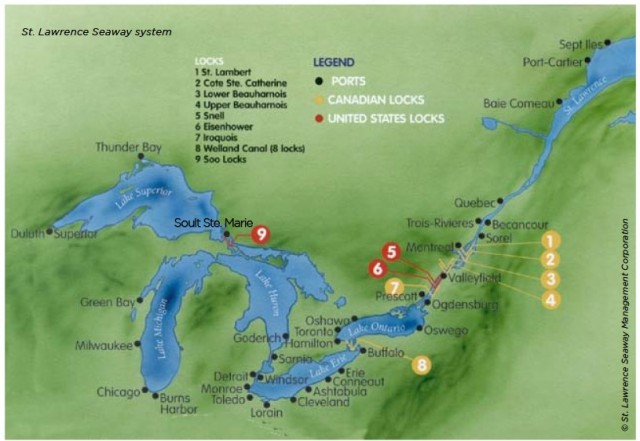The Great Lakes St. Lawrence Seaway System is an inland waterway extending 3,700 km from the Atlantic Ocean to the head of the Great Lakes. It is divided into two sections: First, the St. Lawrence River that extends from the Atlantic to the Port of Montreal which is open to navigation all year. Second there is the St. Lawrence Seaway portion of the system which was opened to navigation in 1959 and extends from Montreal to the head of the Great Lakes. This section is closed to navigation in the winter, normally from late December to late March.
St. Lawrence Seaway is a partnership between the U.S. and Canada. Administration of the system is shared by two entities, the Saint Lawrence Seaway Development Corp. in the U.S., a federal agency within the U.S. Department of Transportation, and The St. Lawrence Seaway Manage-ment Corporation in Canada, a non-profit corporation.
Overcoming 3.700 km of seaway and 19 locks
The Seaway counts a total of 19 locks. From Montreal to Lake Ontario there are two American and five Canadian locks, through the Welland Canal there are eight Canadian locks and over the St. Mary‘s River stretch there are four more American parallel locks, which are operated by the US Army Corps of Engineers. Virtually every commodity imaginable moves on the Great Lakes Seaway System and annual commerce on the System exceeds 180 million metric tons. Major goods moving on the Seaway include: Iron ore for the steel industry, coal for power generation and steel production, limestone for construction and steel industries, grain for overseas markets, general cargo, such as iron and steel products and heavy machinery, and other bulk as cement, salt and stone aggregates.
The vessels trading the Great Lakes fall into two groups; the resident lakes bulk carriers or „lakers‘, that normally only trade the Great Lakes, and ocean going vessels or „salties‘. The maximum size a vessel is permitted in the Seaway is 225.5 m in length, and 23.7 m in beam, 8.08 m draft, and 35.5 m height above water. The channels in the Seaway are maintained at 8.2 m minimum (over the chart datum).
BBC Jade – the last ‘salty’ in the Seaway 2010
In December 2010, the M/V BBC Jade was on her way inbound to Sault Ste Marie loaded with steel from Argentina, further scheduled to take on windmill lashing equipment and frames from Windsor destined for Denmark. Due to delays on route the M/V BBC Jade entered the St. Lawrence Seaway at Montreal on the morning of December 14th.
The regular steaming time from entering the Seaway at Montreal to Sault Ste Marie and back to Montreal is 8 days. However, at the end of the navigation season one has to account for many delays due to weather, ice, and restrictions to navigation. The Seaway Corporation had advised BBC that the vessel must clear the Seaway by the latest at midnight on December 24th as the Seaway would be closing for the winter. This means there were 10 days left to complete the voyage. It seems this was a mission impossible as 5 days for discharging and loading had to be accounted for as a minimum.
Since the vessel arrived at the first lock inward on the Seaway after December 9th, the M/V BBC Jade was designated as a wintering ship, meaning the vessel had to acknowledge that a down bound transit was not assured and the Seaway would make no guarantees as to their ability to successfully transit the vessel down bound and out of the Seaway prior to closing.
The M/V BBC Jade arrived at Sault Ste Marie at noon on December 18 and quickly started to discharge. Due to the very tight schedule, labor was arranged to work round the clock and the vessel completed unloading in the afternoon of December 21 and sailed out that same evening.
Soon after departing from Sault Ste Marie, the master had to drop anchor in a narrow section of the St Mary‘s river were the channel is only 90 m wide. The vessel just ahead of the BBC Jade, a Canadian flag laker, the M/V Cedarglen was stuck hard in the ice. It took two USCG ice breakers almost 24 hours to free the M/V Cedarglen and the BBC Jade finally resumed its trip to Windsor on December 22nd at 20:00 hrs .
Going the extra mile to get things done
The BBC Jade had lost a full day. The vessel arrived in Windsor late in the afternoon on December 23rd and started loading the same day. Again, special shifts were arranged to work round the clock and loading was completed on Christmas evening and the BBC Jade left port on Christmas day at 08:00 hrs heading back to Montreal. Since the BBC Jade missed the deadline for closing, a special permission to transit the Seaway after the announced closing was arranged.
The vessel left St. Lambert Lock at 02:00 hrs on the 28th of December, being the last ocean-going vessel to leave the Seaway which officially closed for winter the next day.
The master and crew were happy to be out „just in time‘ for New Year ’s Eve!
Introducing LOFI = ‘Last out, first in’
It seems almost like this last escape before the winter marked BBC’s destiny to have the right to first enter the seaway this spring. It was at 12:48h local time on March 22, 2011 when the chartered-in M/V AVONBORG was the first oceangoing commercial vessel to enter the St. Lawrence Seaway up-bound at St. Lambert Lock. BBC Chartering proudly introduces ‘last out, first in’!

Based on a submission from Ross Fletcher, BBC Chartering Canada